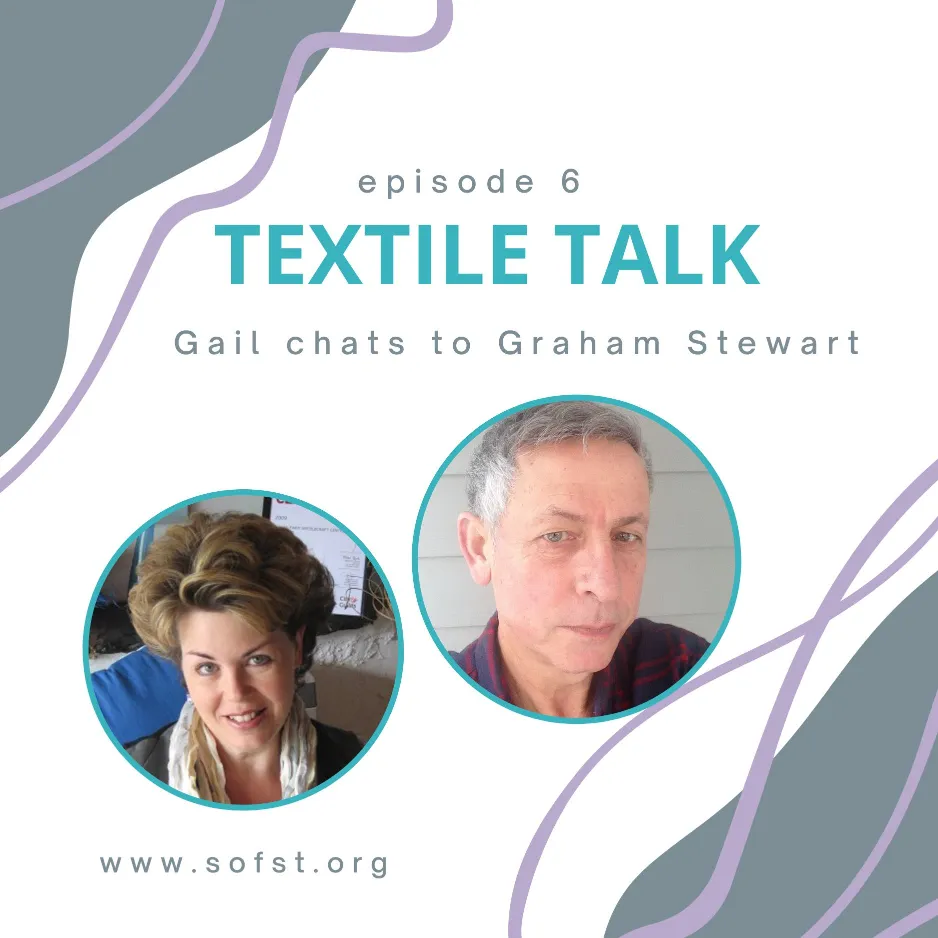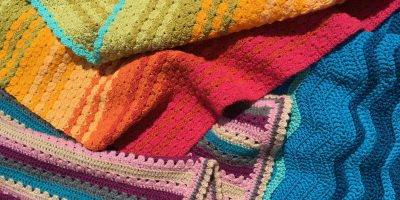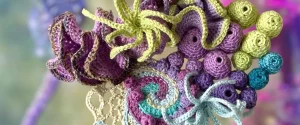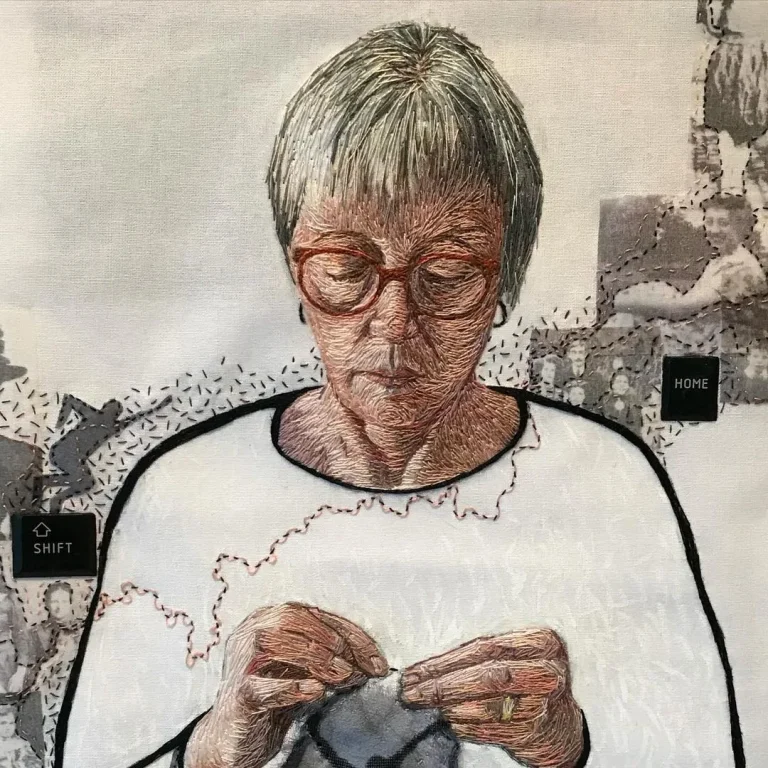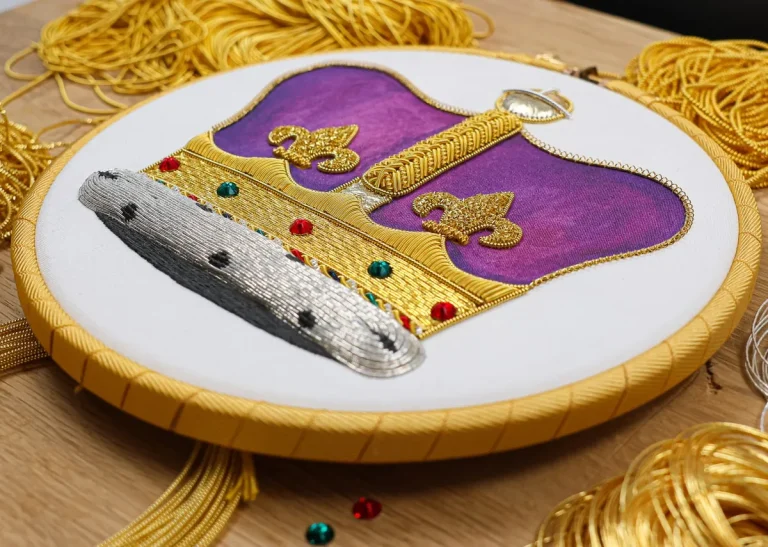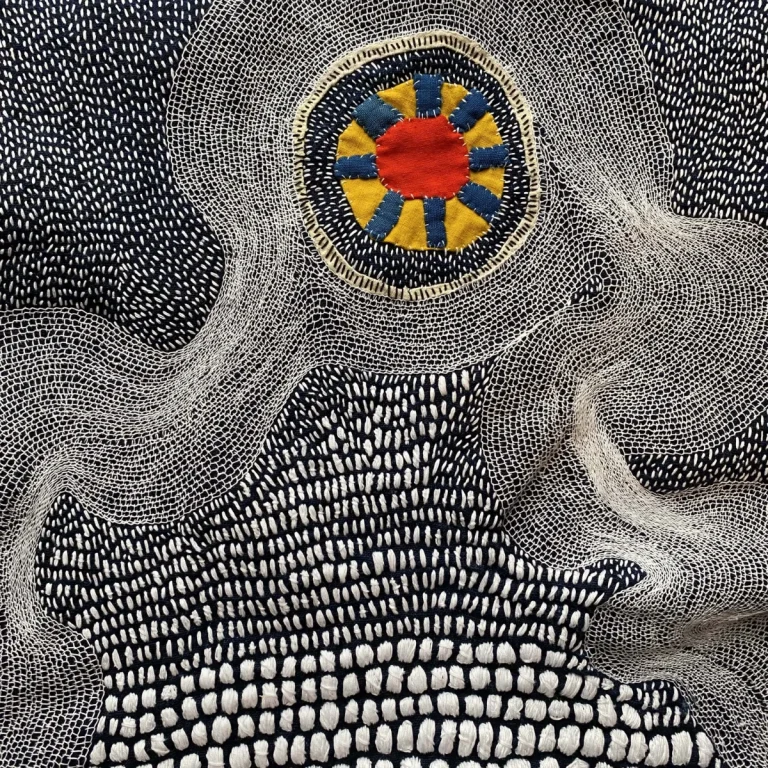In episode 6 of our Textile Talk podcast – where we interview with inspiring artists – we talk to Graham Stewart from Fibre52.
Textile Talk with Graham Stewart
Listen to the podcast now or read through the transcript below.
Graham Stewart - Fibre52

Graham Stewart is an international textile and apparel production fibre specialist. Graham has developed and patented a more sustainable process to bleach and dye cotton called Fibre52.
Fibre52 is an environmentally kind and cost conscious process for cotton dying. It’s a simple, inexpensive replacement for traditional and outdated cotton preparation methods.
Gail: Hello, everyone, and a very warm welcome to this Textile Talk podcast. I’m Gail Cowley, and I’ll be your host today. Joining me is Graham Stewart, who’s an international textile and apparel production fibre specialist.
Just to give you a little bit of background on Graham before we begin, for the past two years, Graham has developed and patented a more sustainable process to bleach and dye cotton called fibre52. fibre52 is an environmentally kind and cost conscious process for cotton dying. It’s a simple, inexpensive replacement for traditional and outdated cotton preparation methods. It uses natural products instead of heavy chemicals, working at a lower temperature with less energy, less water, and a shorter processing time. This makes it a wonderfully cost effective, eco conscious and sustainable bleach and dye process.
All this means that consumers will soon be offered a more natural and ecologically sound choice of fabric. With fibre52, the natural cotton is stronger, recyclable and biodegradable, making it a natural replacement for plastic. A really warm welcome to this episode of Textile Talk podcast, and I’m delighted to have you here, not least, actually, because so many of our followers and students are becoming increasingly concerned about the effect that some of their dying and printing is actually having. And it will be really interesting to hear your take on which direction that’s going in, so I’m sure they will be fascinated.
Graham: Well, thank you again. Thanks for inviting me on the pod.
Gail: I was expecting an American accent, so you’ve thrown me slightly.
Graham: Yeah, I’m from Huddersfield.
Gail: That would do it.
Graham: So my American accent is not that great, I got to tell you.
Gail: Yeah, but obviously you are at the moment in America.
Graham: Yeah, I’ve been here ten years this time around. Yeah. So interesting that City and Guilds is still going strong.
Gail: Oh, yes, you’ve obviously heard of it.
Graham: Well, I have a full technological certificate. City and Guilds in textiles and dying.
Gail: Right.
Graham: That got me into the Society of Dyers and Colourists, and I did my degree in Bradford University part time. What about yourself? Where did you study?
Gail: I actually studied well, initially I did my City and Guilds with Opus in London, and then I went on to do a B tech and then eventually a degree in design and textiles.
Graham: Oh, wonderful.
Gail: And then later on to do a master’s and a PhD in Education. I don’t think I’ve ever got out of the education bug.
Graham: No, I mean, that’s a great thing. I’m very much involved with education here with NC State University. Funnily enough, one of the professors is a guy who studied at Huddersfield Polytechnic when I did in 1979, would you believe?
Gail: Oh, really?
Graham: Yeah. Dr. Professor Andrew West is a great guy, and we do a lot of work. In fact, there’s a young lady doing her thesis right now on fibre52, which we may discuss in this podcast. So, yeah, I’m up there just about every week. Fantastic. 35,000 people there would you believe?
Gail: My goodness, that is a lot.
Graham: It’s a lot. It really is. You should try parking there.
Gail: Anyway, I wonder if I could ask you to just start off by telling us a little about what an international textile and apparel production fibre specialist does. Because I know that is your title, it’s quite a long one, so I just like to know a little bit more about your role, if possible.
Graham: I’m not sure where that title comes from. It does sound pretty grand.
Gail: It does, isn’t it?
Graham: Yeah. None of that was ever planned, I can tell you now. But the reason I guess I get that such a grand handle is that I’ve been the textile industry ever since I was started as a dyer, 15 years old in Huddersfield. We’re the largest commission dyer in Europe. We had ten dye houses and Huddersfield was the largest producer of dye stuff in the world in those days. The ICI was at the back of my house, 300 yards away. Everybody in my street worked there, 6000 people. They invented many different dye stuff, but particularly reactive dyes, which are so prominent in the world, just about everything you wear is reactive dyed. And again, maybe we’ll talk about sometimes the bad press that dyes, like that get, which some of it is uncalled for, some of it not.
But certainly I left England probably, I don’t know, 25 years ago. I was working in the wool industry. Well, sorry, I should go back to England. I worked for Dawson International. I was director of Dawson International in Edinburgh. We’re the largest cashmere company in the world. And then, my fault, we branched into America back in the 80s. We had 4500 people in Pennsylvania making cotton thermals and then that was kind of called John Morgan. Then we bought Duofold, which was in every mom and pop store in America, every ski store, you name it. Fantastic brand, still going. Then I joined the wool industry, went to Italy, lived in Italy for a few years. Then I was called to go to head office in Adelaide, Australia. Lived there on and off for ten years, spent five years in China, worked for the Hong Kong. I worked for the largest knitwear company in the world, Novel Industries in Hong Kong. We own Tommy Hilfiger and all sorts of other things. The largest wound spinner in the world. So I guess I cut my teeth with some fairly large players.
Gail: You did, didn’t you? Yes. What an amazing journey. Not just from a professional point of view, but just from a geographical point of view. You’ve just been to so many countries.
Graham: Well, yeah, I mean, again, the textile world moves, but that’s only halfway through, I’m sorry to say. I then joined Shanghai challenge textiles. We had three and a half thousand people downtown Shanghai made 30 million garments a year, totally vertical. And then I moved to Bosman, Montana, partnered with a rancher, I should say fine wool grower in America. Had to forge the whole supply chain, which I think will be very interesting to anybody who is involved in craft. Because we went from actually shearing the sheep, which was a big deal that took a week, to shear all those sheep, measuring the wool objectively, which hadn’t been done in America, and then spinning, knitting, weaving, dying, finishing, cut and sewed the garments. Did the whole deal. And that’s what got me to fibre 52 because as a dyer, the dye houses here just let me do what I wanted, to be honest, providing I paid. And they’d say you go and do it because there’s very little there was no wool dying in in certainly in circular knits just didn’t exist and knits didn’t exist.
Now they do and they also got very much involved with the US forces in making base layers and outerwearth for them as well in wool, which is a fantastic fibre. But then I kind of pivoted into cotton. I’ve processed a lot of cotton in my life and very much, very deep into it. We have inquiry from all over the globe right now for fibre 52, for a more sustainable way to process cotton. It’s been done the same way for about 80 years and it’s strange that it’s never been looked upon to be done in a more sustainable manner. And that’s what we’re doing and it’s moving quickly. So hopefully that brings you up to date. Without taking too long, I apologize, but I sound like 107 years old, but.
Gail: It’s fascinating and I won’t be rude enough to ask what your exact age is.
Graham: Thanks.
Gail: Mainly because I don’t want you to ask me the question back. Obviously, that’s a fabulous introduction to you personally and you worked with so many different fibres because I sort of had the thought that I was coming on to touch you about cotton. But now I’m really tempted to two sidetrack onto wool as well.
Graham: Yeah, wool has been a big part of my life and so has cashmere just as much as wool, in that I spend a lot of time, even though my own brand with cashmere. It’s a beautiful fibre. Wool is the best, though it’s so complex in comparison to any other fibre. It’s massively complex or complicated, I should say, in that we don’t really understand how wool works and how you should deal with it. It always has some surprises. Cotton, in a way is a much simpler fibre to deal with because they’re.
Gail: Both such natural fibres, aren’t they? So I suppose we tend to almost class them in a similar way, really.
Graham: Yeah, I mean, they’re quite opposite in that you’ve got wool as a protein based fibre, whereas cottons, obviously cellulose and so the dye stuffs are mainly different. But I have to say, in this past year or so, we’ve been dying all over the world and particularly of late, we’ve been doing a lot in Italy, only due to the fact that I have a lot of contacts and friends in the textile industry in Italy, and it’s moved very quickly there. And we’ve found that we can dye using direct dyes. I’m not sure whether you’re affair with direct dyes.
Gail: I am, yes, to an extent, but only in a very small production capacity, in that I would be advising a student to use them or but not obviously to the extent that you will be using them.
Graham: Yes, we use reactives and we use directs, but directs are cheaper. They don’t have the fastest properties that reactives have yet. We’re finding quite the opposite in this, because the way that we treat Cotton I can’t tell you how this process works in any big detail, because we don’t have an NDA, and our company lawyers are really good, nice people. But we have to be careful, because this process is transferable anywhere in the world into all existing machinery. That’s the good side.
The downside is it’s transferable all over the world in any existing machinery. That’s a big problem. I have to be careful what I say, but the way we do it has caused some very nice surprises, I have to say, in that we dye at much 58 degrees lower than normal. With direct dyes, we shave about 2 hours off the whole process. We use up to 70% less water, 70% up to 70% less energy. And I’ve got to qualify this. It depends on the age of your machinery. It depends where you are in the world. But certainly we’re finding these are good surprises. Surprises are always good, but we’re getting tremendous fastnesses. Last week I was in a dye house in South Carolina and the dyer said they can have problems the way that you do it. Put it that way, the fastnesses will be very poor. But to his surprise, , the shade came up exactly. We could hardly see any difference on a spectrophotometer to their normal traditional dying, but we don’t use the heavy chemicals that are normally used in cotton, we use bioproducts.
Gail: Really?
Graham: Yeah, it’s all bioproduct, and that’s the shock to dyers. And they said, your fastness is going to be terrible, but the toughest fastness is really the wet rubbing fastness and we got five out of five for that, which even surprised me, I have to say. It varies a little bit, but we usually get in four to five. So anyway, that’s that’s the cotton industry. So if you want to talk about something else, Gail, please do.
Gail: No, I’m just I’m actually fascinated to hear that it will be transferable to any machinery that’s out there. What are your events or plans for it? Graham? Do you plan to patent, obviously, the process and then sell the process into places or how does that work?
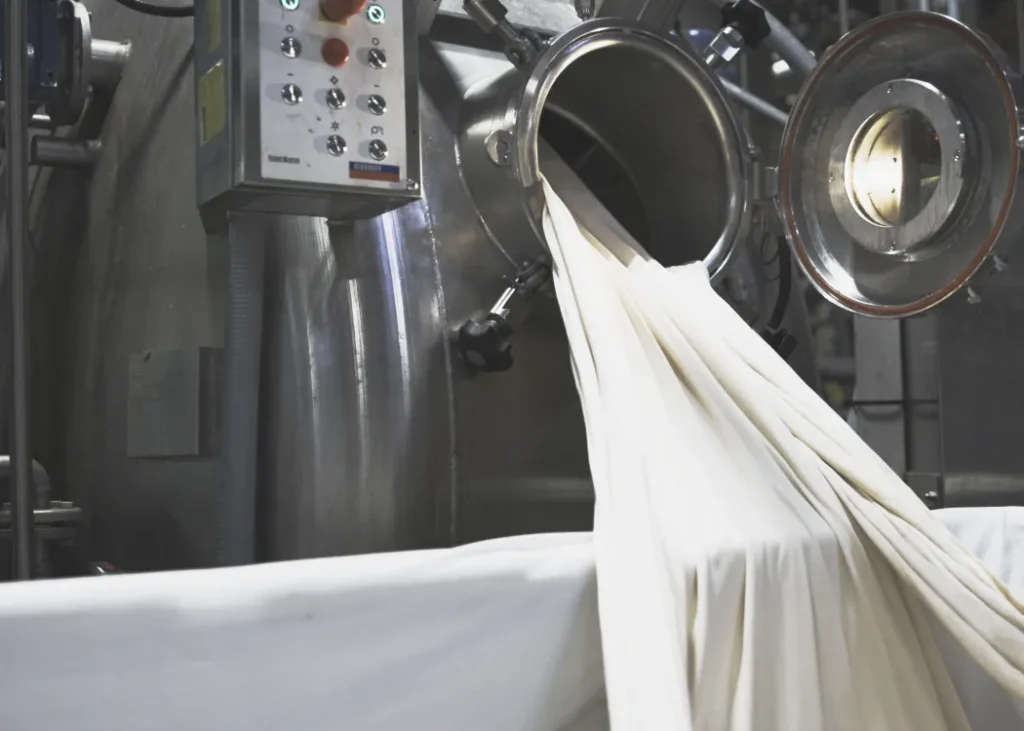
Graham: That’s very smart. You’re one of the few people that’s got that. We actually are going to do that. We have three patents pending, all in late stage now, and I can explain a little bit what that means. But yeah, the patents we’re patenting worldwide, which is super expensive, let me tell you. But we feel confident enough that we’ve got something here, but we’re already rolling out commercially now, and we charge you a small royalty for this process. I’m sorry, we can’t do it for individuals, but we either do it with brands, and we’ve got the largest brands in the world working with us right now, but we work with their manufacturers, and we either charge the brand of royalty or the manufacturer royalty, and in some cases both, depending on the agreements that we make.
Gail: I see. And where do you see it eventually ending up? Do you think that, looking at it from sort of a small crafter’s point of view, do you think we will ever see that dye or that dye process for sale in a small batch way?
Graham: Yes, I do. And I want to do that, or we want to do that, I should say, me and my colleagues. I see this process being, I don’t know, maybe 80% of the world’s cotton processing sometime. It probably won’t be in the next year or two, but, you know, people can’t continue to use heavy chemicals, heavy alkali in some countries already, I won’t mention the countries, but they’re in South America right now. They haven’t banned using these heavy chemicals, but they’re already on a watch list and the government are saying you got to get these out your system within the next year or so. It’s interesting that that’s happening. So the more enlightened processors around the world are already starting to do that. Legislation is coming in, let’s face it, what’s happening with the United Nations for 2030 and so on. With the sustainability goals, this kind of process just has to be used. And it’s so easy. It’s even easier than the standard processing. And so why not? Look, I’m an avid craft dye myself, and I love to use natural dyes and so on, and me and my daughter do quite a bit of dying, actually, in a bucket in the sink.
Gail: I think that’s called taking your work home with you, isn’t it?
Graham: It really is. Once you’re in this industry, it’s hard to get away from it. And I just enjoy to use natural dyes as well. Not that they’re as sustainable as people sometimes make out, but they’re okay. That’s what I do. I play with not using the metals that are sometimes used in natural dye.
Gail: Because it’s important, isn’t it, that causes the issue.
Graham: That’s right. And with these bioproducts, you can actually get rid of the mordants, which is causing the issue, and use bioproduct instead of mordants. And that’s in one of my patents, actually.
Gail: I know sometimes traditionally things like lead were used for mordents as well, weren’t they?
Graham: Chrome was the big one in the past, so we used chrome dyes and then they became Premetalized. They still have metals in them with the name premetallized. They’re still being used but less and less. To your questions, that’s the direction of the industry. It just has to be more sustainable. I know we use that word far too often, but that’s the way I just don’t know what else to say. That’s the way the industry is going and that’s the way we all will go. I guess even those of us who are craft fabric and yarn dyers, lose fibre, whatever, we’re going to change our ways, I think. Tremendously interesting.
Gail: Yes, it’s certainly something that people are very much aware of and I think as well, actually, the younger people are perhaps the more aware they are. Maybe they hear more about it in school, perhaps they talk more about it, but it is something that they seem to be much more aware of than perhaps older people are.
Graham: Definitely, yeah, undoubtedly. I think where I grew up in Huddersfield, we would bet on what colour the river was going to run that day. It was red or green. It’s terrible. I look back in shame as to what we did do.
Gail: You’ve moved the process on tremendously, but do you think that there’s still scope there for moving it further in the future?
Graham: Yeah, I mean, our company policy is very much to put anything that we earn out of fibre 52, we’re going to reinvest because we also, you know, we’ve talked about cashmere, we’ve talked about wool and so on. We’re going to at some point roll these kind of processes into those fibres also. So we’re not looking to make a profit anytime soon. Our whole theory is let’s do this better and one day we might turn a profit. But it’s not a priority right now and it’s good to have partners that think in that manner. Our priority is to do things right and also to use that, as I say, to use anything that we do gain out of selling this process or license in this process. We’ll get into other fibres as well and maybe of the textiles. We’re also already in trials with Nonwovens, for instance, which is a huge category, as you know, and in cotton in this case, there are two distinct parts to processing. There’s to prepare for dye bleach and then there’s dying in cotton. You have to, and I’m sure your listeners know this, you really do have to use a bleaching process and that’s where all the damage is done because of the heavy alkali with hydrogen peroxide and I mean, we all use hydrogen peroxide, right? I mean, I use it to clean my teeth, so hydrogen peroxide is fine. What you put with it is a problem and we also are able to go straight from that bleaching process into dying without dropping the dye bath, which saves 10,000 liters per 1000 fibre. So this kind of thing really is a big deal in the cotton industry because, as you know, cotton is a big fibre. It’s the second largest fibre type in the world, after polyester, and it’s natural, which polyester obviously isn’t.
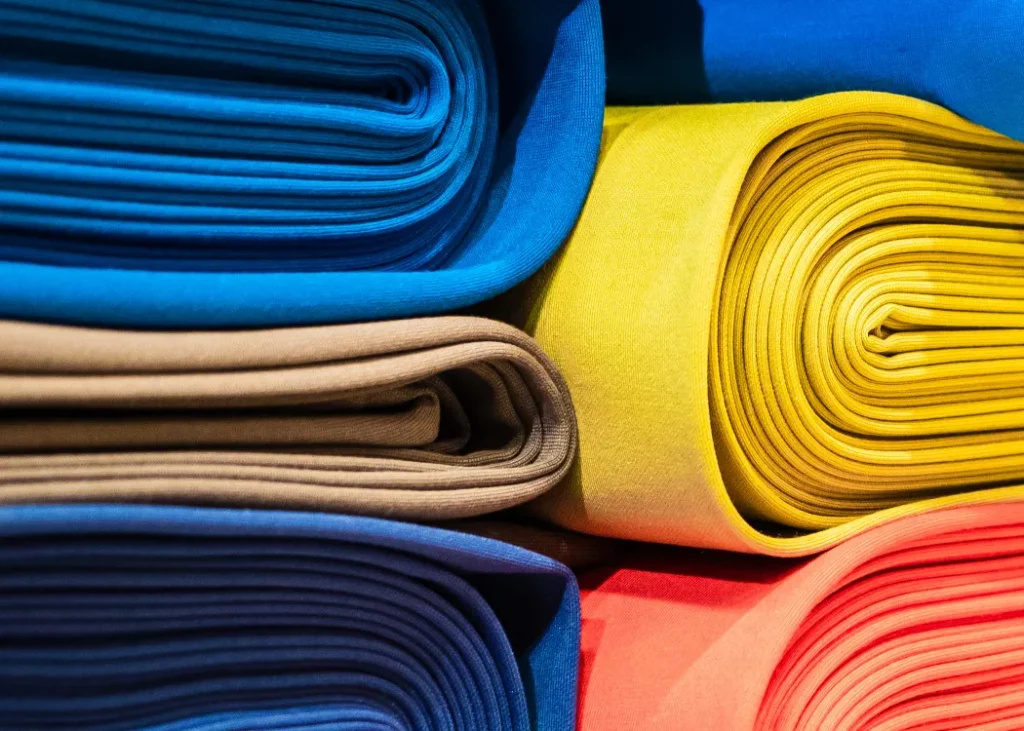
Gail: Where do you source the cotton from? Which countries does it come from?
Graham: Well, right now, here in the Carolinas, obviously, I live amongst the cotton fields. I’m in South Carolina. I drive to North Carolina every week, and I drive through hundreds of miles of cotton fields. Also, my partners are based in Houston, Texas, which is the largest cotton growing area in North America. About 50% of America’s cotton comes out of Texas. But when I’m on the West Coast, which I go to the West Coast every three to four weeks, where there’s a large textile industry in dying and cutting. So for garments there, most of the cotton I’m using comes out of India. So, yeah, the cotton I’m processing is mainly coming from the US or India.
Gail: How much difference does the original cotton, the quality of it, have on the dye process?
Graham: Tremendous difference. And that’s possibly, again, where we’re putting a focus on this, is that most dyers just don’t really care what’s on the fibre. Basically, they just have to clean it up and get going. Let’s get dying. Let’s get going. And so what we do is we actually extract whatever’s on the fibre, and we do an analysis. One we analyse quantitatively how much there is on the fibre and qualitatively what it is that’s on the fibre. And so we’re engaging much more now with the growers as well, where we can in the world. That’s a big deal for us. We really want to get into that because it does affect the process in a big way, and it affects the quality of the final product, which we want to focus upon to have the best final product that you can actually get.
Gail: I seem to recall hearing in perhaps in years past that there have been problems with cotton. There’s been a crop failure. Are the stocks of cotton still pretty plentiful?
Graham: Yeah, still. The cotton industry has not got as much cotton worldwide or free cotton, let’s put it that way, because there’s been issues in China that we all know about. There are issues in India with organic cotton, and the pandemic has not helped that there is a slow recovery, but yeah, getting back to normal, but not quite there yet.
Gail: So usually when there’s a scarcity, there’s an increase in price. And I presume that we would expect, therefore, to see cotton going up over the next few years.
Graham: Yeah, it went up started to go up about two years ago. But there have been tremendous increases in price in cotton.
Gail: So it’s obviously increasingly important to make the most of what’s out there. And perhaps in the way that we think of cashmere or silk as being a luxury fabric, maybe we’ll be taking the same view over cotton.
Graham: We already are. I mean, we’re dealing with one of the world’s largest luxury groups right now. Sorry, that cotton, Indian cotton, spun in Japan. Yeah. Talk about a global industry. Indian cotton spun in Japan, knitted in Italy, and woven in Italy. Tremendous, by the way. Just the most gorgeous fibre you can imagine. And that’s looking at cotton in a different way. It’s looking at cotton as a luxury fibre, not just a mass market. And the product that comes out in the end is fabulous. But I think to your point, what’s really important is that even the dyers that we deal with have to learn how to cost. Right? It’s not your first cost. It’s not the cost of the products that are going into it, like the chemicals we always get. Oh, look, this chemicals cost so much. What does your bio product cost? We’re not far off. We’re more or less the same. But when you look at saving up to 70% of water, up to 50%, let’s say, of energy, your carbon footprints up to 50% less. And the time involved as well is up to 50% less. Once you cost that in, there’s a great big difference. This more sustainable way of dying and processing is way cheaper than normal.
Gail: Well, I think we’re all aware, aren’t we, just how much the cost of energy has gone up?
Graham: Yes, absolutely. I mean, the dyer that we work with mainly in Italy, their costs have increased ten times tenfold in the last two years. Can you believe that?
Gail: That’s huge, isn’t it?
Graham: Yeah.
Gail: I presume, as you say, this is a very global process. Is that absolutely necessary? Is there a reason why some of these processes can’t be done where the cotton is grown?
Graham: Yeah, cotton, being an agricultural product, isn’t growing in the cities or like Los Angeles. Some of the biggest dyehouses in the world are there, right. Downtown. I can put my finger on 300,000lb of processing in a day. Downtown LA. There’s not much cotton being grown in LA. I can tell you amongst the 18 million inhabitants, that probably maybe explains it somewhere. But, yeah, you know, and then cotton in India is grown in the rural areas.
Gail: I just sort of wondering why it needs to go from being grown in India to then going to Japan to then going to Italy. It seems as though there’s going to be quite a consideration in travel cost for it as it moves from place to place.
Graham: That’s right. That’s why that particular supply chain probably won’t exist much longer. Maybe one of the big guys wants to use it. But even then, as you say, the publicity is not great when you shipping it 10,000 miles. But there again, back to your question. Look at Texas, a State I think, bigger than Britain and it’s very rural, so you got to ship it and there’s no spinning, there’s no real textile industry in Texas, so you got to ship it somewhere. And it usually comes to either goes to the west coast of America, to the producers there, or to the Carolinas, or bit to the west of us, to Alabama and Georgia, or it’s shipped somewhere. So, yeah, unfortunately, right now we don’t have any alternative, but cotton gets shipped around the world and that’s just a fact of life and I don’t think that’s going to change a great deal, to be honest.
Gail: I think it’s quite hard to change things like that, isn’t it? More plants would have to be set up and obviously, I presume that you need a level of expertise from workers in that area as well.
Graham: Yeah. Cotton is not the easiest fibre to grow. You do need knowledge, a lot of knowledge, to grow the fibre itself. It’s the same with wool. If you want really good wool, you better know what you’re doing right from the shearing, because it makes an enormous difference as to how the finished product is. It’s the same with Cotton, it’s actually even the same with synthetic fibres to an extent, but not as much as with these natural fibres.
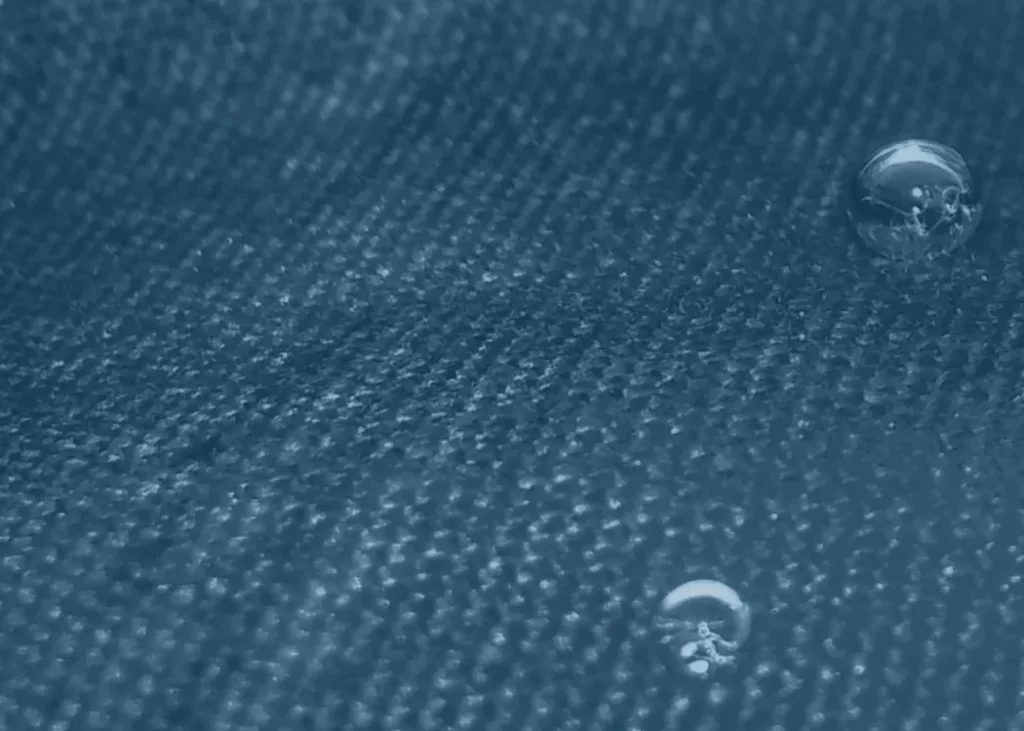
Gail: We’ve talked about the price of cotton going up, but actually the price of wood is going down, isn’t it?
Graham: No, fine wool is going up pretty strongly at the moment, so I haven’t looked at this week’s report. I’ve been a wool guy, I get every report you can imagine on wool pricing. There’s two sides to wool. There’s the wool that goes into our apparel and then there’s the wool that goes into carpets and other things. So furnishings. So if you look at the broader wools that are not used in apparel or not much used in apparel, they’re often used in outerwear, but mainly they’re used in furnishings and carpets and so on. The price of those wools has been pretty low for the last 10-15 years in apparel wools, fine wools out of Australia and New Zealand, South Africa, they’re on the rise and will continue to do so, I believe. I’ve often been wrong, by the way, being a wool trader, you get it wrong all the time. You just hope you don’t get it wrong too often.
Gail: Obviously, we’re not too far here from the Lake District, and Cumbria is famous for wool, and I hear a lot of farmers complaining about how low the price that they’re getting for a fleece now is.
Graham: Yeah, that’s because England, as we all know, Gail, it rains a lot and we have beautiful grass. That means broader wool. So in Australia, where it’s dry, where I lived in Adelaide, and over in Sydney, to the north of Sydney, the fine wools there are grown in mainly low rainfall areas. Adelaide would have maybe ten inches a year of rain, whereas Huddersfield gets about 45 a year. And the Lake District more the Lake District, I can’t imagine how much rain there is. But that means broader wool. And there’s the price problem, because, I mean, it’s beautiful wool, by the way. The wool that’s grown in Britain is fabulous, but it’s broader in general.
Gail: And how would that translate into a finished item?
Graham: Those broader wools are used, and when I was younger, we had a big carpet industry in the UK, if you remember, Kidderminster, the Kidderminster carpet, Axminster Wilton, the most famous carpets in the world were made in Britain. Those were made from the broader wools, British broader wools. That’s how that industry started. Also in Wales, we would be dying all the yarns for the tapestry industry in Wales, which existed in those days.
Gail: Really?
Graham: Yeah. And that was, again, broader wools, beautiful tapestries and coats. The coats that were made from those tapestry woven fabrics were just amazing. And a lot of that industry has dyed. I do know that there is still carpet manufacturing in the UK, and in fact, we’re working with this dyer in Great Britain, quite a large dyer, who’s a yarn dyer, and they’re thriving with cotton, but they also dye. Quite a lot of wool also, which is mainly grown in the UK.
Gail: Yes, because yarn crafts have become much more popular recently.
Graham: Yeah. And I think those British wools are beautiful. I mean, my daughter is in the next room. She’s crocheting as we speak. She’s using wool from England and she does a lot over a period of time. And those wools are just fabulous for hand knitting, which, again, is an industry, I think, that’s increasing. When I was in Australia, I used to sell what we call 28.8 micron wool to China, and we would sell 20 million kilos a year into China just for hand knitting. I’m not sure that industry exists anymore, but it used to be enormous.
Gail: Yeah, I certainly think that the quality that I’ve seen for sale for hand knitting, yarn and crochet yarn has increased substantially recently.
Graham: Yes, I see it here, too. We go and buy wool from our local stores and it’s hard to get, to be honest. The ones that we want to do, you can buy a few bobbins, but when you go back to try and buy it, it’s gone. You can’t buy the same colour again. That’s the demand that’s happening. These are big stores, too. I go to Walmart, would you believe? Just enormous stores here. We buy at Walmart, or we go to there’s a big craft store called Michaels, which tends to be in the bigger towns and cities in the US, very beautiful yarns. They have a big section selling yarns and selling fabrics and so on. Yarns are hard to come by, especially in wool. They’re harder. The cotton and blends you can get, but in wool, it’s tough.
Gail: Yeah. We seem to have a. Lot of small producers nearby, perhaps because of the amount of sheep that we have in this area. And you can get some lovely small batch dyed yarns, but I don’t think they’re being mass produced. They’re just small producers.
Graham: Yeah. And I think I see a massive demand for that kind of product here in the US. This market would have amazing potential for those smaller guys in the UK. I just don’t see any of it.
Gail: Yes. Which is a shame.
Graham: Yeah, it is. It’s a big shame because the market is pretty much untapped, and there’s just that pent up demand for that kind of wool yarn, or even rovings wool tops, as we call them. Again, huge demand for that kind of.
Gail: Used for felt and things.
Graham: Because, you see, in America, the wool industry is actually a sheep industry, so it’s more of a meat industry. So I think Britain actually has quite an advantage in the you know, the quality of those broader wools is exceptional.
Gail: So cycling back to fibre 52, do you imagine that there will be any production for small crafters in their respective fabrics that they could use for craft, or do you see that it being used in that way?
Graham: I do. It’s pretty much as we were just discussing with the craft people in the UK. There’s no reason why here in the US. I already see that there’s a big craft business I think I shouldn’t do, but I use those dyes that you can buy in Walmart and so on the weekend. And again, the shortage is incredible. It’s really hard to find them because more and more people are buying those packaged dye kits and using them at home and processing fabrics and yarns and fibres at home. So I do see I see enormous growth in this industry, in this craft industry, which is great, obviously.
Gail: I know that the States has a real tradition in quilting and quilting fabrics.
Graham: Yes.
Gail: And that’s obviously something that our listeners would be interested in. And I’m sure that they would also want, if they possibly could, to purchase those fabrics that they’re going to use to make, for example, a quilt. If they knew that they were produced in an ecologically friendly way, I’m sure that they would wish to purchase. Do you have any advice for them as to how they could make sure that what they’re purchasing for their craft projects is kind to the environment?
Graham: Yeah, maybe at a craft level, it’s easy to do. If I can just relate to the apparel industry in general, you’ve got the big guys, and I think they’re the same retailers in apparel in England as they are in the US. And I always look on the labels to find out where the product is from. You’ll get labels that say it’s recycled and all this stuff. You don’t really know that you don’t have any detail. Retailers are under pressure to bring more of that information to consumers.
I think in the craft industry, it might be a bit easier, and I find this it’s a bit easier to find out where your product is coming from and what processes it’s been through and in fact, you’re processing it yourself anyway, but it’s a little bit easier. But it’s not as I don’t know what to say. Transparent as it should be, we all have to spend more time and more money in actually telling everybody where your fibres come from, what supply chain that’s been through, and very importantly, what is on that fibre, how is that being processed? Because that’s what we need to find out. And again, that information is not so readily available. Unfortunate. And that’s what we’ve got to work on. That’s part of the spend that we will have. We’re happy to spend as much as it takes without turning a profit. We’re happy to spend as much as it takes to make that supply chain visible.
Gail: Yes. A couple of things that come to mind. Often when you’re buying some fabric to make a quilt, you’re buying it off a bolt of fabric and you obviously there might be if you’re lucky, there might be some information actually on the end of the bolt, but you don’t really tend to bring that away with you. Equally, sometimes the retailer will cut up that fabric into small pieces, so you never actually see the original bolt of fabric at all. I wonder if we will start to see some specialist retailers that will make a point of just trading in ecologically friendly fabrics.
Graham: Absolutely. I think, again, that’s down to the work that you do and your listeners are doing in that consumer demand is going to drive that. I want to know where my fabric comes from and I go to my local store and as I say, these are mass stores, they’re all over America, but there’s zero, I mean zero information as to where that fabric has come from. Yeah, in the case that you mentioned there, in the bolt of fabric that goes into quilts, you just can’t find it. And that has to happen, let’s face it, in this whole stitch industry, we have to know what we’re working with.
Gail: Well, I suppose most things that we tend to buy, be they in the realm of groceries or even a bottle of wine, tends to have ingredients on it. So we’re told how many calories it contains, where it’s been produced, that sort of thing. Surely it would be a step forward to start to bring that towards fabrics, I would imagine.
Graham: Yeah. I mean, it’s up to legislation. I mean, the legislation is just not there. That’s the problem. So in America, there’s not much, to be honest, how many people talk about it. But where I see it happening is in the EU in Italy, for instance. Those manufacturers are under such pressure from the EU because they are legislating. So you’re going to know where your products coming from in those markets and it will happen here in America. That legislation has to happen. I’m sure you see the same yourself, but bodies like the United Nations and so on have put in a lot guidance out there and so on have put in a lot of pressure on governments to legislate, and that can only be good.
Gail: Yes. No, I’m sure. I suppose the problem is, well, it’s still possible to get cheap fabrics that haven’t been ethically produced that will obviously reflect in the price, and some people will always choose to go for the cheapest option.
Graham: Yeah, that’s the majority of the mass market. I mean, the dye houses that I work with, there are fabrics coming in from overseas, very, very cheap fabrics in huge quantities. They don’t know what’s on the fabric. As you probably know, most woven fabrics have got what you call size on it, so you can actually weave the fabric. They don’t know what size is on it. And so they have lots of dye problems because they don’t even know what’s on the fabric itself. That’s how weak legislation is and it shouldn’t remain like that.
Gail: Now, I think sometimes crafters have problems actually relating how that might affect themselves and their own crafting experience. I think most people that have quilted or that have used purchased fabrics for any length of time will have run across them that obviously haven’t been well dyed. The moment you put them into the wash, the colour starts to run and it can absolutely ruin a project. Of course, if you got a red piece in the middle and suddenly it’s around everything else by the time it comes out of the washing machine. So I think there is an element of trying to educate or explain to crafters just why it is a good idea, not just from the point of view of being ecologically sound, but to know that what you’re using is coming from a reliable source.
Graham: Yeah, I mean, what’s on the label even from a reliable source? Let’s face it, you often see a label that this is being done with dyes that more natural, so some may wash off and so on. At least if you know that you’re fine, put your red fabric in with a white fabric and therefore you end up with a pink. But certainly that again, back to legislation. Whatever care labels exist, it should say what your dye steps are going to do if it is going to wash it separately. Hand wash, cool wash, all those instructions are so important when it comes to caring. Those care labels are so important. I just hope that more and more information is put there on those labels so we can all have fibres, yarns and fabrics that we can work with with more confidence.
Gail: Do you have any advice and obviously things are as they are at the moment, and we very much hope that ecological dying, ecologically sound dying will be the way forward for the future. But as things stand right now, do you have any advice for our students or for anybody that’s thinking about dying, some fabric, how they can help to reduce their footprint?
Graham: Yeah, I think it’s down to education. I mean, you mentioned what we mentioned early on the City and Guilds courses, and there are so many courses available online, there’s so much education and I think you’re involved in that Gail, if I’m not mistaken.
Gail: Yes, that’s right.
Graham: Well, it’s good to learn. Just to go online and do a course, doesn’t matter how basic it is to begin with, but build your knowledge, that’s going to help tremendously. So education really is important.
Gail: Is there anything that they can do when they’re considering which dyes to buy? Is there some that are better than others, in your opinion?
Graham: Well, it depends. Again, it depends on the fibres that you’re dying. We talked about natural dyes. One of the issues with natural dyes is what we call the tinctorial effect, in that some dyes don’t have a high tint effect, whereas I talked about reactive dyes, which were invented in the 1950s and widely used. Just about everything that we wear these days can have reactive dyes in, they build up very well. So that tinctorial power is huge, which helps in processing, it helps to save water, it helps to save the dye stuff.
Unfortunately, there’s no easy answer. Again, education helps and doing your homework helps because there are so many different dye stuff, but you can look at certain groups of dye stuff like reactors, directs and so on. And again, the way that something’s dyed really should be on the labels more and more and the education should be towards this is where you can get it, this is your reliable supply. So I hope that answers your question because it’s a big question.
Gail: Yes, my apologies. It was a big question, wasn’t it? I think that students, obviously they want to be able to dye their own fabrics because you can get some fabulous effects. Having said that, many of them now will want to look at a natural way using leaves, various sort of maybe onion skins, various things, but it’s not a strong effect, is it? So you got some lovely natural colours, but they’re not going to really ping out at you and yeah, it’s a very different effect to the dye that you would buy, which would give a very, very strong colour.
Graham: Yeah, it’s very difficult. I mean, I know I’m having beetroot for dinner tonight when we peel them, we bought 5lb of beetroot yesterday. When we peel them, we will use those peels, but we can dye pink. But also you can play a little bit with other natural products which will turn that pink into a blue or a green or whatever. It’s good to experiment, but not to use chemicals, not to use heavy chemicals. Use whatever is natural. And to me that’s fabulous. I enjoy that. But yes, you’re not going to build a very strong colour that way and you don’t want to waste vegetables to try and do it like the peels are on the side and so on. Great. Use them.
Gail: Yeah. I do remember many years ago when I was living at home as a child and my granddad got me to grow a couple of rows of beetroots. At that stage it was a bit of a surprise that you actually had to cook them to boil them. And I remember doing the whole lot at one time and the kitchen looked as though somebody had committed a bloody murder. I’ve never seen so much pigment in my entire life.
Graham: Well, yeah, I think again, you’ve hit a good point there and even when you’ve peeled them, you still got to boil them and you can use the liquid that you’ve boiled them in and it is pretty strong from beetroot. That’s a really good vegetable to use. Yeah, I had the same circumstance myself. We used to grow a lot of beetroots when I was a kid.
Gail: So is there anything else, Graham, that you think we haven’t touched upon?
Graham: No, I think as you say, Gail, we’ve touched on quite a lot. Very important back to what we said is please be a voice as well. Please put pressure on for labelling, for better information, for better quality information, to understand what you are getting as somebody who’s sewing or processing on an individual basis or with a group of friends, because the groundswell there is really important. I think this craft industry is just going to grow. I mean, you tell me you know more about it than I do. I just think it’s going to be an enormous growth area in the next few years.
Gail: I agree. I do actually think that people are getting a lot more discerning as well. In some ways. There’ll always be a mass market out there and they will have perhaps whatever’s cheapest and maybe that’s all they can afford. And I am not for one moment commenting on that, but in my experience, a lot of people now are getting much more discerning about what they use to do their craft work. Because if you’re going to spend a lot of time on something and you’re going to put a lot of work into it and you’re going to have pleasure out of spending that time and doing that work, it’s much nicer to work with something that is beautiful to handle that you know where it’s come from, that it’s not going to run, or that it’s going to be printed straight, that sort of thing. So there are real positives, not just ecological benefits, but real positives to the individual to use a quality product. And as you say, I think it’s going to be how do we perhaps, going forward, persuade people to do that?
Graham: Yeah, what a good point. On Friday, I met with my colleague up in North Carolina who has a kind of brand. He’s the most sustainable person I’ve ever met. He’s in the textile industry. He’s been there for a long time. He deals with the growers, the cotton growers, right through to the shirt, he calls it. I think he actually trademarked it. Dirt to shirt.
Gail: A great name.
Graham: It’s a big thing. Yeah. And I think he does 10,000 shirts a year in the Dirt to shirt process, which he monitors very carefully. But he said to me on Friday night, and I keep forgetting this, he said, Graham, you got to remember, we’re wasting so much. And he has a garment dyehouse. The reason is it’s the only garment dye house in the East Side of America, right in Los Angeles.
There are a lot of small and some quite large garment dyers here on the East Coast. We don’t have that much. I think there’s only this one and I’m going to be fortunate enough to be dying in that dye house very soon. But he said, look at the mass market. Somebody says, look, this pink is going to be or this green is going to be the colour in 2023. And they make as much of that colour as they can. And then guess what? It changed. And he said to me, do you ever monitor the wastage? And I can’t monitor it. But he said we should be thinking about the wastage that there is in apparel, as you say, in home furnishings and so on, where goods are made and never sold. That was this question, where did it go? And he said, that is a huge problem worldwide.
The point is, like he said, I can dye 20 garments in my dye vessels. And by the way, he uses a lot of avocado pips. I won’t mention the chain, but all the avocados that are sold through this chain in America go to him and he boils down the pips and makes the most beautiful colour for his dirty colours. So there’s no wastage. Zero wastage. And now we’re all working on this. And then one project I’m working on right now with him is that we want to bring that down to even where you can order your shirt individually rather than have somebody who makes 5000 and you get one of them.
Gail: Yeah. What a great idea.
Graham: Yeah. Yeah, it’s a great idea. It’s just tough to do.
Gail: Yeah, I can imagine it is. Yes. But it’s a great idea. And as you say, there would be, in that case, zero waste.
Graham: Zero waste. That’s what we all aim for.
Gail: It has been an absolute pleasure today having you here. And I’ve learned an awful lot about fabrics and fibres that I didn’t know beforehand. So thank you so much for that.
Graham: Well, thank you, Gail. Thanks for all your questions, and hope we can keep in touch.


